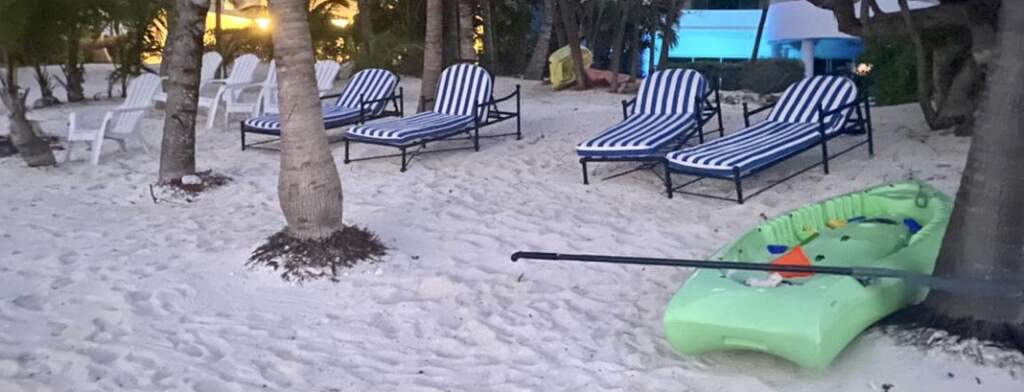It is the biggest event in Quintana Roo, it lasts six months of the year, and it occurs right here on Akumal’s beaches. It brings in more tourism dollars than we can count — but what are we doing to ensure its survival? Some are doing absolutely nothing!
The question is: Are Akumal’s beaches turtle ready?
The answer is: They are not!
Beach chairs, tables, umbrellas, and kayaks litter the beaches from Half Moon Bay to South Akumal creating obstacles for mother turtles entering our beaches to begin the nesting process.


If a turtle encounters one of these obstacles while she is searching for the perfect spot to lay her eggs, she will do one of two things:
1) Abandon her efforts and head back to sea, aborting 100-150 eggs in the ocean, or
2) Plough through the obstacle posing danger to herself, the nest, and the baby turtles incubating in it.



Then there is the problem of white light — it lights up the beach from inside homes when draperies are not closed at night. The white light from outdoor terraces, yards, and pools are equally detrimental.
Nesting mother’s prefer to come out of the sea in darkness. Unfortunately, a white terrace light looks exactly like the moon. Many turtles will simply choose not to come out of the water because it’s too bright. When this happens, the risk of aborting her eggs in the ocean is high. Research has proven that red light irritates the mother’s and babies less, allowing them greater success at doing what Mother Nature wants them to do — survive!


Another problem with white light is it attracts baby turtles as they hatch. Their natural instinct is to go toward the brightest light, which should be the moon over the ocean drawing them toward the sanctuary of the sea. But if the brightest light is shining from a house, they end up on terraces, hallways, roadways, in grassy areas, shrubbery, and in pools.
Too many baby turtles die because they never find their way to the ocean.

Or worse, they die from predator attack. The baby turtles are decapitated, their bodies left strewn in a trail of other dead baby turtles, all headed towards the brightest light they were attracted to. The next morning volunteers clean up the remains; otherwise they would remain there, rotting in the sand. It is not a glamorous sight!
Is the survival of sea turtles worth the inconvenience of moving obstacles and living without white light for six months? Absolutely!
What can each of us do?

1) Exchange the white light bulbs for red light bulbs.
Believe it or not, owners of these valuable beachfront properties are offered FREE red light bulbs thanks to a large donation to CEA from Terry Richardson. Yet even this does not entice some to participate.
2) Move obstacles further up the beach and onto your property, out of the way of the nesting area.
3) Block access to your pools using furniture and kayaks as a blockade.
4) If you come across a turtle, DO NOT APPROACH. Alert a member of security or a trained member of CEA (identification is carried by each member).
5) Contact the Akumal Ecological Center (CEA) to report or express concerns, abnormalities, or violations of the law regarding nesting activities, nests, or hatchlings at 984-280-3798 (for turtle emergencies only)
It’s that simple!

Unfortunately, many owners and managers simply refuse to cooperate, some forget, and some don’t care enough to pay attention to the request. A little effort will go a long way to ensure successful nesting and hatching.
What would happen if the turtles stopped coming to these beaches completely?
Guaranteed, tourism would slow down! This in turn would affect the general economy and locals from the Pueblo would lose jobs. It would affect income to businesses and vacation rental owners, which in turn affects property values.
Akumal, isn’t it time we all do our part?
And if you are being responsible, then make it your duty to offer friendly encouragement to the neighbors around you to do what is right and what is best for these matriarchs of the sea!



The author writes an excellent article with valuable information and pictures telling us all why and more importantly how we can all make a difference to assist our beloved turtles and help make their nesting and hatching easier and safer.